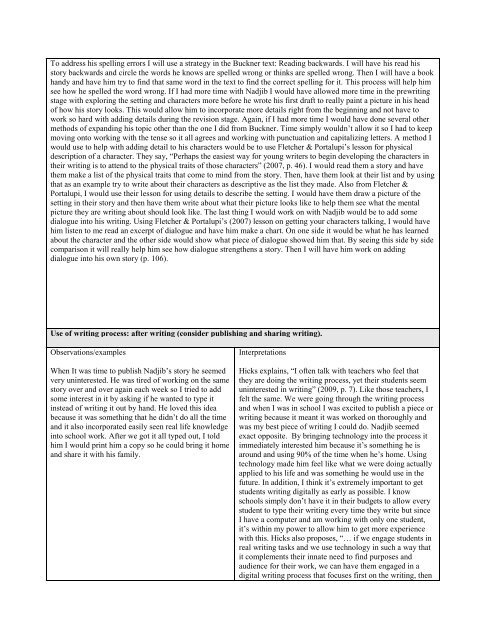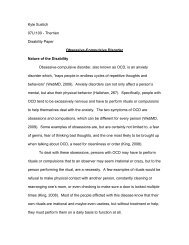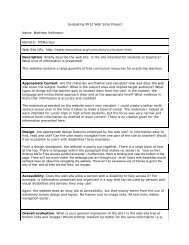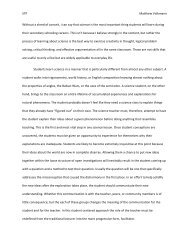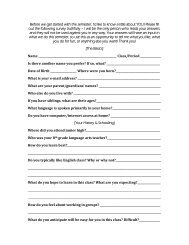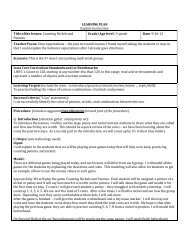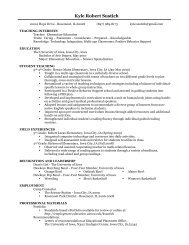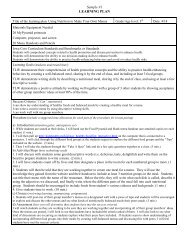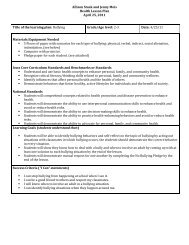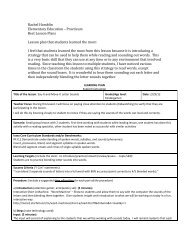Writing child study - Employment
Writing child study - Employment
Writing child study - Employment
You also want an ePaper? Increase the reach of your titles
YUMPU automatically turns print PDFs into web optimized ePapers that Google loves.
To address his spelling errors I will use a strategy in the Buckner text: Reading backwards. I will have his read his<br />
story backwards and circle the words he knows are spelled wrong or thinks are spelled wrong. Then I will have a book<br />
handy and have him try to find that same word in the text to find the correct spelling for it. This process will help him<br />
see how he spelled the word wrong. If I had more time with Nadjib I would have allowed more time in the prewriting<br />
stage with exploring the setting and characters more before he wrote his first draft to really paint a picture in his head<br />
of how his story looks. This would allow him to incorporate more details right from the beginning and not have to<br />
work so hard with adding details during the revision stage. Again, if I had more time I would have done several other<br />
methods of expanding his topic other than the one I did from Buckner. Time simply wouldn’t allow it so I had to keep<br />
moving onto working with the tense so it all agrees and working with punctuation and capitalizing letters. A method I<br />
would use to help with adding detail to his characters would be to use Fletcher & Portalupi’s lesson for physical<br />
description of a character. They say, “Perhaps the easiest way for young writers to begin developing the characters in<br />
their writing is to attend to the physical traits of those characters” (2007, p. 46). I would read them a story and have<br />
them make a list of the physical traits that come to mind from the story. Then, have them look at their list and by using<br />
that as an example try to write about their characters as descriptive as the list they made. Also from Fletcher &<br />
Portalupi, I would use their lesson for using details to describe the setting. I would have them draw a picture of the<br />
setting in their story and then have them write about what their picture looks like to help them see what the mental<br />
picture they are writing about should look like. The last thing I would work on with Nadjib would be to add some<br />
dialogue into his writing. Using Fletcher & Portalupi’s (2007) lesson on getting your characters talking, I would have<br />
him listen to me read an excerpt of dialogue and have him make a chart. On one side it would be what he has learned<br />
about the character and the other side would show what piece of dialogue showed him that. By seeing this side by side<br />
comparison it will really help him see how dialogue strengthens a story. Then I will have him work on adding<br />
dialogue into his own story (p. 106).<br />
Use of writing process: after writing (consider publishing and sharing writing).<br />
Observations/examples<br />
When It was time to publish Nadjib’s story he seemed<br />
very uninterested. He was tired of working on the same<br />
story over and over again each week so I tried to add<br />
some interest in it by asking if he wanted to type it<br />
instead of writing it out by hand. He loved this idea<br />
because it was something that he didn’t do all the time<br />
and it also incorporated easily seen real life knowledge<br />
into school work. After we got it all typed out, I told<br />
him I would print him a copy so he could bring it home<br />
and share it with his family.<br />
Interpretations<br />
Hicks explains, “I often talk with teachers who feel that<br />
they are doing the writing process, yet their students seem<br />
uninterested in writing” (2009, p. 7). Like those teachers, I<br />
felt the same. We were going through the writing process<br />
and when I was in school I was excited to publish a piece or<br />
writing because it meant it was worked on thoroughly and<br />
was my best piece of writing I could do. Nadjib seemed<br />
exact opposite. By bringing technology into the process it<br />
immediately interested him because it’s something he is<br />
around and using 90% of the time when he’s home. Using<br />
technology made him feel like what we were doing actually<br />
applied to his life and was something he would use in the<br />
future. In addition, I think it’s extremely important to get<br />
students writing digitally as early as possible. I know<br />
schools simply don’t have it in their budgets to allow every<br />
student to type their writing every time they write but since<br />
I have a computer and am working with only one student,<br />
it’s within my power to allow him to get more experience<br />
with this. Hicks also proposes, “… if we engage students in<br />
real writing tasks and we use technology in such a way that<br />
it complements their innate need to find purposes and<br />
audience for their work, we can have them engaged in a<br />
digital writing process that focuses first on the writing, then


